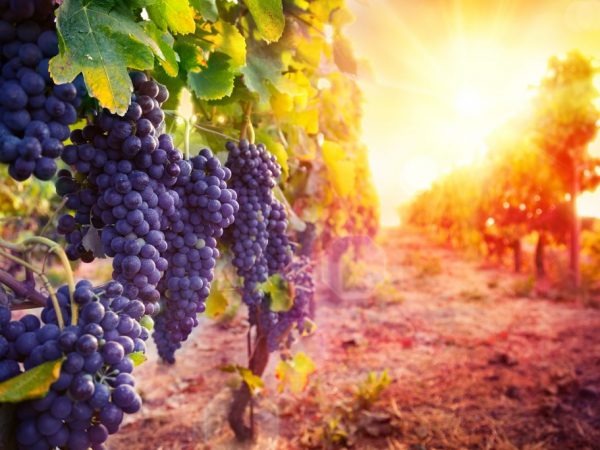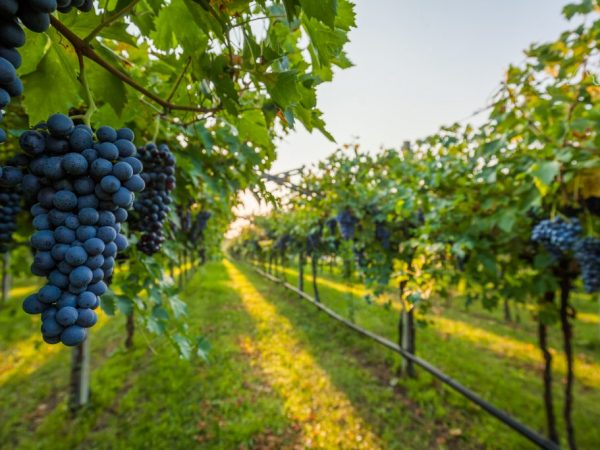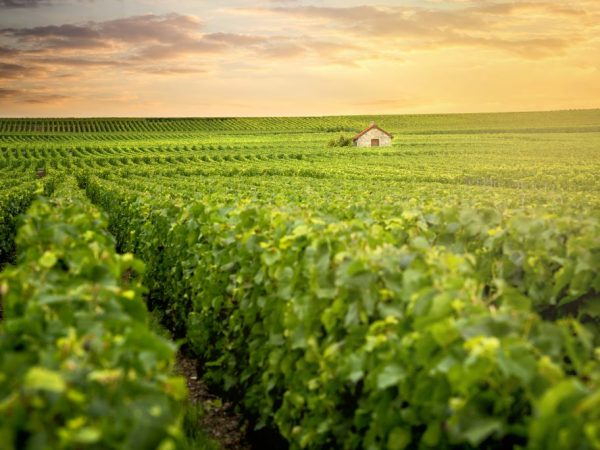World vineyards and winemaking
Almost all regions of the countries that are not covered with snow and ice all year round have several places where grapes are grown. The cultivation of vines for a good harvest for winemaking has long grown into an industrial scale. There are many vineyards, both of global importance and small, local ones.

World vineyards and winemaking
Viticulture of the world
The merit of selection all over the world is called the breeding of grape varieties capable of producing a rich harvest in almost any climatic conditions. In colder regions and the hottest countries, crop cultivation relies on good care, protection, and maintenance of fertility. Varietal variety allows you to choose several harmoniously combined tastes for creating wine drinks.
Lands located between 30 ° and 50 ° North and South latitude on any continent are considered ideal for growing grapes. It is in these regions that the most famous grape fields arose. They were often attached to the possessions of the rulers and the church, since this stratum of the population always had a material and working base for processing vast territories.
Foreign vineyards
Grape fields in different parts of the European continent and America have some common features. They were founded many years ago, and to this day, most of them adhere to the traditions of growing and caring for grapes.
Vineyards are placed on hills, hills, terraced ledges of mountains, in the valleys of rivers and lakes. The wines produced in Greece, Spain, Portugal, Montenegro and Germany have a special character.
French vineyards
The old vineyards of France, like those of Germany, were planted in unsuitable places for this. The principle of choosing regions was based on the proximity of trade routes. Now it has been revealed that the territories located on the eastern side, with poor soils for nutrients and a lack of moisture, give the richest harvest in terms of taste. France's attitude towards vineyards is obvious: they occupy 490 thousand hectares of area.
In the center of the French capital, there is a hill known for its once royal vineyards. Once the hill of Montmartre adorned the monastery, on the territory of which fields for growing vines were laid out. At the moment, they have been reduced to a minimum and moved to the northern part of the hill. Wine made from the berries growing there is popular with tourists, especially during the annual wine festival, but it is too small to be produced for export (1-1.5 thousand bottles).
The birthplace of sparkling wines is called the Champagne region, which is located in eastern France on the border with Luxembourg and Belgium.The hilly terrain is complemented by the restrained northern climate, with the grapes ripening slowly and gradually. These places are known as the vineyards of the golden hills, especially when the autumn hillocks are covered with golden and crimson hues. The soil composition of Champagne is rich in limestone and chalk deposits. The varietal variety includes Chardonnay, Pinot Noir, Pinot Meunier.
Provence belongs to the less significant wine regions, but the drinks produced there have the characteristic features of lightness, sweetness, pleasant fruit and berry aroma. There are several small vineyards on the territory. Popular varieties include Uny Blanc, Cleret, Marsanne, Folle Noir, Spagnol, Bracket.
The Loire Valley is rich in viticulture, producing a wide variety of wines. The climate of this region is so different in character that the same variety can be used to make dry, sweet, sparkling and other wines. The plantations grow grapes of Chenin Blanc, Chardonnay, Muscat, Cleret, Pinot Meunier, etc.
Swiss vineyards
A feature of the cultivation of vines in Switzerland is the relief. The mountainous terrain forced winemakers to use terraced fields on the slopes of high mountains. The soil is not rich, summer in some regions brings hot air, and a lot of snow falls in winter. Almost all wine products are consumed domestically, exporting only 2% of the total.
The beautiful vineyards of Switzerland's golden hills cover ¾ of the French-speaking territory of the country. In the canton of Valais, during warm, sunny and long summers, the Sauvignon variety is grown in the highest vineyards in Europe, which serves as the basis for a spicy white wine.
The Lavaux territory of the canton of Vaud is concentrated on the shores of Lake Geneva from Lausanne to Vevey. They are renowned for the large amount of Chasselas supplied. The Geneva region is characterized by a flat relief, with an equal share of crops for red and white wines.
Wine-growing regions of Italy

Varieties for winemaking are grown in Italy
The history of viticulture and winemaking in Italy begins with the colonization of the Apennine Peninsula by the Greeks. The heyday of viticulture falls on the era of the Roman Empire, which covered the lands of Italy, France, Spain and other states. In the Middle Ages and in the twentieth century, the technology of planting plants and squeezing sap was improved. On the territory of the country, there are 5 main regions for the cultivation of raw wine.
Central Italy is represented by the most popular wine region - Tuscany. Chianti wine is produced here, which is the hallmark of the country. It is based on the Tuscan berries of the Sangiovese vine. Grapes are grown both for red wines (Montepulciano, Cabernet Sauvignon, Chardonnay) and for whites (Trebbiano, Verdicchio, Vernaccia, Malvasia), white viticulture is especially popular in the Lazio region, near Rome.
California vineyards
The first fields were laid by missionaries to grow bunches for the production of church wine for the sacrament in the 18th century. Then the planting did not lend itself to a clear division, which entailed unauthorized pollination and hybridization of varieties. Now the grapes of California are different from their European counterparts, and the wine made from it is characterized by a special taste and aroma.
Now popular vineyards of the Napa Valley, California, as well as the neighboring ones, located in the valleys of Sonoma, Monterey, Santa Barbara. For the production of wine, the varieties Zinfandel, Sauvignon Blanc, Merlot, Pinot Noir, Chardonnay, Chenin Blanc, French Colombard are used. On their basis, breeders grow new varieties of crops in California, using about 110 species in winemaking.
Vineyards of the near abroad
On the territory of Ukraine and Belarus there are vineyards of a large industrial scale, but their number is limited. There are much more small private fields where craftsmen develop new varieties, grow vines for seedlings, cultivate bushes to obtain raw materials for homemade wines and liqueurs, compotes, and jams. People are happy to buy varieties known all over the world, which become more loyal to local climatic conditions.
Popular amateur growers with their own vine fields are:
- Plyasunov Vladimir, Lugansk region, Ukraine;
- Dashevsky, Dnipropetrovsk region, Ukraine;
- Dmitry Reznikov, Lisichansk, Lugansk region, Ukraine;
- Sergei Sidoryako, p. Velyka Znamenka, Kamenko-Dneprovsky district, Zaporozhye region, Ukraine;
- Vadim Tochilin, pos. Mesopotamia, Novopolotsk district, Vitebsk region, Belarus;
- Nikolay Gorbachevsky, Pinsk, Belarus;
- Savran Dmitry and Anatoly, Karlovka, Poltava region, Ukraine;
- Alexander Shmelev, Ukraine;
- Vladimir Shpak, Karlovka, Poltava region, Ukraine;
- Karpova Irina, Kharkov, Ukraine.
Crimean vineyards
The Crimean peninsula is dominated by a warm climate with an average annual rainfall. The soil is saturated with limestone and sandy impurities, which provides a good basis for the cultivation of vines. This is the reason why viticulture and winemaking in this region was founded hundreds of years ago.
The area around the city of Sevastopol is a prime example for the cultivation of grapes. The proximity of the warm Black Sea and protection from cold winds by the Crimean mountains allows this territory to grow a good harvest. A large number of warm sunny days regulate the acidity and sweetness of the berries to a level that makes it possible to make dry, semi-dry, sweet and sparkling wines from many varieties (Dorama, Deliveri, Marta). Vineyards of the Sevastopol zone are used for the production of wine drinks Inkerman - a vintage wines factory, opened in 1961.
Grapes on the territory of Russia

Viticulture is widespread in the south of Russia
The Russian Federation occupies a huge territory, which is characterized by many climatic zones, soil composition and relief storage. Large-scale viticulture is concentrated in the southern regions, where the conditions for growing such a finicky crop are better. People also grow vines in the northern regions, more often at their dacha and their personal plot.
Krasnodar region
One of the most famous large vineyards in Russia is Abrau-Dyurso. It is located in the valley of Lake Abrau riddled with hills. The rocky soil and poor watering make it possible to grow good raw materials for wine drinks in this region. The owner of the vineyards presents the company as the best supplier of sparkling wines. In addition to them, on the basis of berries, wines are made Chardonnay, Riesling, Dark Blend, Light Blend, Cabernet.
The Taman Peninsula is a region with a long history of viticulture, which began about 2000 years ago. The climate and relief of this region are similar to those of the Crimean Peninsula, and therefore the soil composition does not differ from the neighboring part of the mainland either. On Taman, varieties are grown such as;
- white cleret (primary translation - Vivsyanka);
- pinot gris;
- Rhine Riesling;
- aligote;
- saperavi;
- sylvaner.
At the moment, the lands of the peninsula are actively used by French producers. They bring in new elite varieties and improve the method of caring for the bushes. On the territory of the vineyards, tasting rooms are open for tourists, where wine and cognac drinks are served.
According to the map, the territory of Lefkadia is located in the village of Moldavanskoye. This is a winery founded by Mikhail Nikolaev in 2004. It covers 80 hectares of area. Varieties from abroad and domestic are grown, among them Chardonnay, Merlot, Riesling, Sauvignon Blanc, Pinot Noir, Shiraz.
Most of the work on the ground is done by hand, some - with the use of technology. In the production of wine, a mechanical system and French barrels made of Russian oak are used by special order.
Abkhazia
The rich history of winemaking in the Republic of Abkhazia has deep roots. In modern times, the cultivation of grapes is supported by the conditions of the subtropical climate, but in different parts of the region the berries acquire different tastes and aromas. Wine production accounts for almost a third of consumer goods in the economic niche.
Most of the vineyards belong to the Wines and Waters of Abkhazia firm. She makes drinks for sale. Some of them are exported to Russia without imposing duties.
Local residents also have small Abkhaz grape fields. The resulting harvest is processed in an artisanal way into homemade wines with a tart or sweet taste, dried fruits, and rolls.
Folk gardeners
Almost everyone who owns a private house has an amateur garden. The correct marking of even the smallest area allows you to plant young shoots of grape vines. A smart gardener knows how to use all the conditions so that he grows beautiful specimens of different varieties and fructifies within a few years.
In Russia, there are many enthusiasts among winegrowers who grow famous varieties and improve them, as well as plant care techniques. Each of them planted so many different varieties, having tried a lot of techniques and approaches, that even without special education he can be considered a specialist in viticulture. Even Chinese workers can compete with the efficiency and resourcefulness of these people.
Among the popular winegrowers are Vyacheslav Korol, Nikolai Kurdyumov, Yuri Doroshenko, the Krasovsky family.
Conclusion
Viticulture is popular in the regions where it originated many years ago. Vine cultivation relies on mandatory comfortable conditions: climate, relief, soil composition, varietal compliance.
Winemaking is a widespread industry in many countries, but in most cases the activity takes on a local character.


